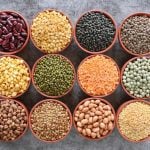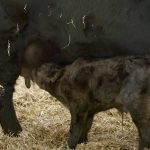
Cow-Calf

Klassen: Feeder cattle market ratchets higher on stronger fed market
For the week ending June 8, Western Canadian feeder cattle markets traded $3 to $6 above week-ago levels. In certain locations, quality packages of 600 pound plus steers were $8 to $10 higher compared to seven days earlier. Alberta packers were buying fed cattle on a dressed basis at $440/cwt, up $2/cwt from the previous […] Read more

Post-calving nutrition to maximize conception rates
Evaluating body condition score can be difficult and requires training
With the current price of calves, targeting high pregnancy rates should be a priority on any cow-calf operation. In addition to remaining pregnant, they must conceive early in the breeding season to maintain a 365-day calving interval and ensure a uniform calf crop. This will promote better returns for the weaned calves and profitability for […] Read more

Shifting to the Sandhills calving system to cut scours in young beef calves
While it’s not for every operation, the Sandhills calving system can reduce diarrhea in young calves
Cow-calf producers across North America face wide-ranging challenges each calving season but scours and neonatal diarrhea often top the list. Various systems are used to help prevent what can become devastating losses when these pathogens gain a foothold. An established approach still growing in popularity is the Sandhills calving system, designed to separate newborns and […] Read more

How to spot respiratory acidosis in a newborn calf
Most beef producers know the frustration that accompanies dealing with the dreaded “dummy calf”. These calves will not suckle, won’t sit up or stand and stare blankly with what seems to be a lack of will and intelligence to survive despite your best efforts. This lack of coordinated movement is often due to respiratory acidosis. […] Read more

How to evaluate newborn calves using the calf VIGOR scoring system
Ideally, after a calf is born, things go well, and the cow and newborn calf thrive. However, it is important for producers to know how to assess calves for subtle signs of distress or trauma that can occur due to a difficult calving. Good vigor is a vital characteristic. A vigorous newborn calf has the best chance […] Read more

Changing feeding programs after calving
Nutrition with Barry Yaremcio
Cows and bred heifers require 25 per cent more nutrients after calving than during late pregnancy. Milk production peaks eight weeks after calving. Feed intake increases until 12 weeks after calving. The increased feed intake is the result of the digestive system expanding to fill the space that was occupied by the fetus and reproductive […] Read more

Surviving scours
Prevention is the best medicine, but when you’re in the middle of an outbreak, it’s all about getting through it
Scours. It should be a four-lettered word, for all the misery it causes on cow-calf operations. Even with the best preventative practices, outbreaks can pop up in herds. And in the middle of an outbreak, the focus is on survival, for calves and humans alike. During an outbreak, producers are generally going to see a […] Read more

Using reproductive tract scoring to pick replacement heifers
A project at the Livestock and Forage Centre of Excellence is comparing conception rates of replacements to earlier reproductive tract scores
In Canadian beef cattle systems, increased efficiency accompanied by higher levels of performance is largely dependent on the female herd delivering live calves within a desired time frame. Most commercial operators retain and develop heifers for potential replacements. When adding numbers and quality to the herd, these yearlings become a critical piece of the puzzle. […] Read more

What to consider when changing the breeding season
Producers tightening or shifting their breeding season should consider everything from economics to feeding programs
Trudging through slushy snow in April is a scene many producers know well. One day there’s a hint of summer in the air, with birds chirping in trees overhead as a farmer checks on newborn calves frolicking near puddles. The next day, the farmer is rushing through pastures as hard sleet slashes his face, trying […] Read more

Klassen: Year-end buying interest boosts feeder market
Feedlot operators gearing up for shortfall in overall numbers in the first half of 2024
Strength was noted in calves under 650 pounds while feeders over 700 pounds were relatively unchanged. Larger packages of weaned quality genetics were $8 to $10 higher in some cases.



